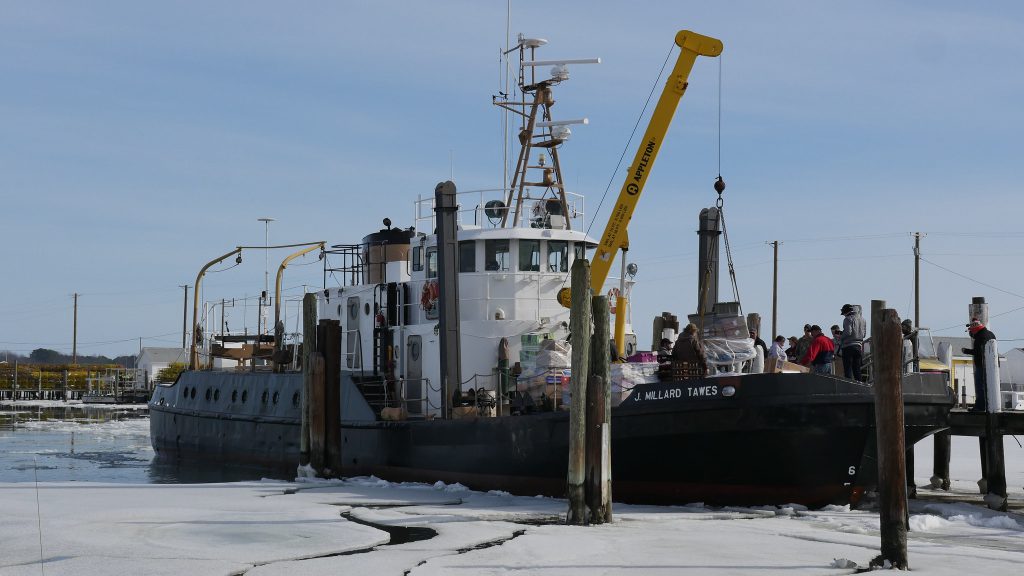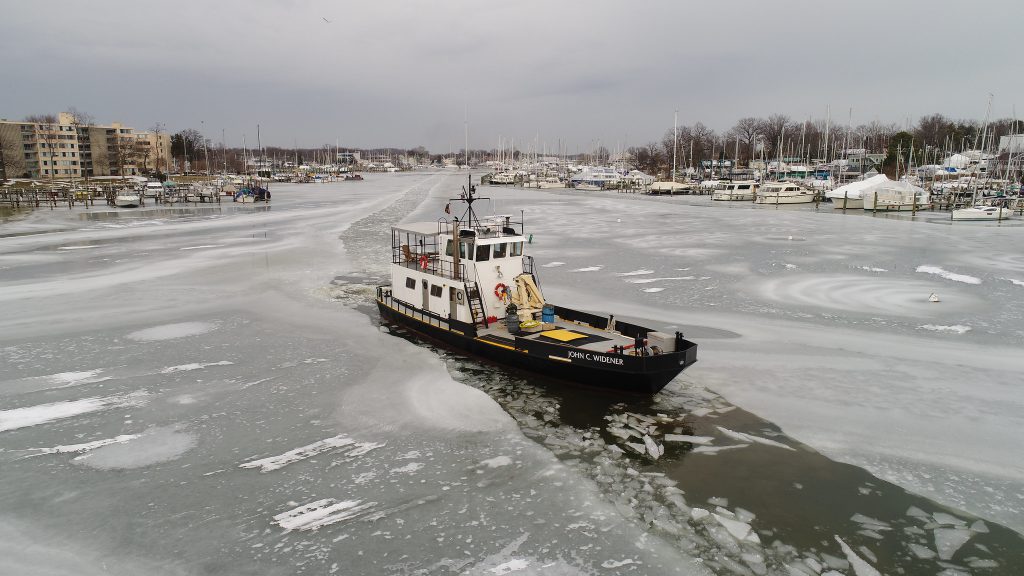Sailing into History: Department’s Largest Vessel Ready for Retirement
For more than four decades, the waters of the lower Eastern Shore have had a large protector.
The J. Millard Tawes is the Maryland Department of Natural Resources’ largest vessel at 100 feet long and 167 tons. The boat was originally commissioned by the United States Coast Guard in 1942 under the name Barberry; the federal government surplussed the vessel and it was brought into the department’s service in 1972.
The Tawes still serves as the primary icebreaking asset for Crisfield Harbor and Smith Island. Tangier Island and other parts of Virginia have received the vessel’s assistance when the Chesapeake Bay islands are cut off from their normal supply sources by heavy ice. During heavy ice seasons, all food, fuel, medicine, and emergency transport going to and from the islands have been supplied by the Tawes.
Because of the relative safety the boat’s size provides, it can be used for evacuating Smith Island at the behest of Maryland Emergency Management Agency during dangerous weather events such as hurricanes. The Tawes serves as backup for the U.S. Coast Guard as icebreaking vessel for the Port of Salisbury—the second-busiest port in Maryland, handling much of the fuel and dry bulk deliveries for the Eastern Shore.
As a buoy tender, Tawes’ large capacity allows it to safely carry more than 20,000 deck loads. This capacity allows the Tawes to trans-port large weights up to 900 pounds that are used to secure buoys in the open waters of the lower Chesapeake Bay and Pocomoke and Tangier sounds. These buoys protect the boating public, marking channels and underwater hazards. Additionally, the Tawes crew marks natural resource areas, supporting the Maryland Natural Resources Police in their conservation efforts.
However, the time has come for the department to retire the old vessel. Staff has had increasing difficulty maintaining the 77-year-old Tawes. Most of its major systems—for example, the main engines that drive it—have not been manufactured since 1980, so when parts are needed they must be fabricated.
The Department of Natural Resources has placed a solicitation for design and construction of a replacement vessel, one that is purpose-built for the required missions, with lowered maintenance costs. For the past several years, the department has dedicated a portion of the Waterway Improvement Fund—which is paid by the state’s boating excise tax—to pay for the project.
The new vessel will have a large task following in the wake of the J. Milliard Tawes—which goes into a well-earned retirement after decades serving the boating public and the Eastern Shore’s waterfront communities.
The Natural Resources Fleet
The Maryland Department of Natural Resources employs dozens of boats for various scientific and enforcement duties, including water monitoring, boating safety patrols, search and rescue, ice breaking, various aquatic life surveys, and many others. Most are smaller boats that are not officially named. Those that are named carry one of two ship prefixes—M/V, for “motor vessel,” or R/V for “research vessel.”
The department’s Hydrographic Operations team, based at Matapeake on the Eastern Shore, operates four large boats that perform various duties through the Chesapeake Bay. The department’s boats are shallow draft, meaning they can get into rivers and shallow areas of the bay.
Hydrographic Operations’ main functions are:
• Placing and maintaining more than 2,000 aids to navigation, speeds zones, hazards, and other regulatory markers in support of natural resource areas and the boating public,
• Providing charting and ice-breaking services, and
• Assisting in the removal of tons of dangerous debris and abandoned boats from public waterways.
| M/V J.M. Tawes | M/V J.C. Widener | M/V A. V. Sandusky | Big Lou | |
| Type | Buoy tender | Buoy tender | Buoy tender | Tug |
| Length x Width | 100 x 24 feet | 73 x 20 feet | 80 x 24 feet | 50 x 16 feet |
| Draft | 5 feet | 5.5 feet | 4.5 feet | 6 feet |
| Tonnage | 178 | 75 | 120 | 27 |
| Built | 1942 | 1964 | 1989 | 1967 |
| Engine | 1,000 HP | 525 HP | 700 HP | 450 HP |
| Icebreaking capability | 18 inches | 6-8 inches | 8 inches | 6 inches |
| Base | Crisfield Harbor, Somers Cove Marina | Annapolis Harbor | Kent Narrows | Cambridge Harbor |
| Captain | Lee Daniels | Jeff Lill | Shawn Orr | Steven Konka |
John Gallagher is director of hydrographic operations for the Maryland Department of Natural Resources. Appears in Vol. 23, No. 1 of the Maryland Natural Resource magazine, spring 2020.



 1-888-373-7888
1-888-373-7888 233733
233733